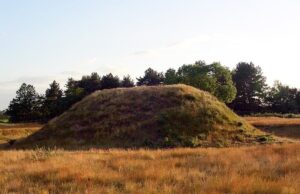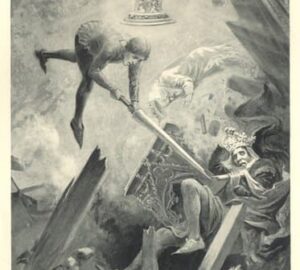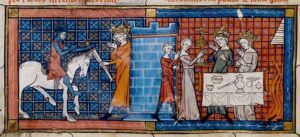•
(Caution: Contains spoilers for Episodes: S07E03: The Fisher King and a bit of S03E03: Judgement Day)
Diesen Beitrag gibt es auch auf Deutsch.
•
Near to the village Midsomer Priors, on the site of today’s Midsomer Barrow, in Celtic times, during the Iron Age, 3000 years ago, there was a local chieftain: the Fisher King. He was a wealthy man and died of the dolorous stroke, a symbolic death: he was stabbed in the thigh with a spear. (Note: Paul Heartley-Reade calls it the dolorous blow, but in the context of Arthurian legend it’s called a stroke).

The backstory is, as is typical of Midsomer, somewhat convoluted and intertwined: In 1974, Paul Heartley-Reade obtained permission from the landowner, Roger Heldman, to excavate a burial mound on his estate. The excavation team included archaeologists Dr Lavery and Paul Heartley-Reade, as well as the landowner, Roger Heldman. During the excavation, the three discovered that it was the tomb of the legendary Fisher King and found a chalice and a spear inside.
However, a tragic incident occurred during the excavation: While they were still documenting, the entrance to the mound collapsed, killing Roger – or so the story goes. However, the post-mortem revealed that Roger Heldman was murdered – just like the Celtic Fisher King of Midsomer. A second alleged case occurred shortly afterwards: Paul Heartley-Reade is said to have died in a car crash. In reality, he is on the run, having murdered Roger Heldman out of jealousy: his wife had been raped by him. Roger Heldman is David’s father. (One of four paternities in Midsomer Barrow, and all by rape. What a bastard).
The Revenge
Paul fakes his own death and takes another name before returning to Midsomer Priors and Midsomer Barrow, Per Hansen, but we stay with his real name.

First, Paul murdered Roger’s son Gareth Heldman by using exactly the same way that the Iron Age Midsomer Fisher King died: by a stab to the thigh, which severed his femoral artery and led to a reaction between the primitive iron and the blood in his body, causing his death – so George Bullard.
Shortly thereafter, Paul Heartley-Reade is deeply disappointed and feels as betrayed by his supposed son David as he did by his real father Roger: David passes off Paul’s scientific findings as his own. It is Miriam Heartley-Reade, of all people, who approaches Paul after his guided tour along Midsomer Barrow and hands him David’s book, “The Hidden Celtic Way”. We see it in the local bookshop, and a year later Elizabeth Keys from Fletcher’s Cross is holding it in her hands at the reopening of the station, talking to Tom Barnaby.
At sunrise after the shortest night of the year, David wanted to perform a Celtic ritual to save his marriage to Miriam: Just as he shoots a flaming arrow towards the rising sun on the horizon from the top of the burial mound, another arrow hits him from behind and pierces him fatally. When he rolls down, he is already dead. (Incorrectly performed on 21 June, Summer Solstice. In fact, this ritual was celebrated back then by the Celts on Beltane, the 1st of May. The same day as the stag night.)
The Iron Age Arthurian Fisher King
We learn about the legend of the Fisher King on the aforementioned guided tour by Paul Heartley-Reade, in which Joyce Barnaby also takes part. The legend of the Fisher King is part of the Arthurian legend, although not the original one, but an addition made a few centuries later. We’ll come to him in a moment. But there is also a link from the Fisher King legend to Midsomer Barrow.
Paul Heartley-Reade does not elaborate on this in this scene, but he does a little later, during the interrogation by DCI Tom Barnaby: The Fisher King did not live in Anglo-Saxon times (like King Arthur), but in Celtic times. His grave was found about 30 years ago on the estate of Roger Heldman. This Fisher King died of the same injury that wounded the Fisher King in Arthurian legend. The dolorous stroke, the thrust into the thigh with a spear or lance.
The Fisher King in the Arthurian legend
And now for the Fisher King of the Arthurian legend: there are various versions of the legend of the Fisher King, but what they all have in common is that Pelles (other sources call him Parlan or Pellam) was the guardian of the Holy Grail and the Spear of Longinus. That’s the spear that was used to pierce Jesus’ side and the chalice that was used to catch his blood.
But Pelles messed up – and the details of what exactly he did vary from version to version.
In any case, it was either a knight of King Arthur’s court or God himself who delivered the ‘dolorous stroke’ that gravely wounded Pelles. Pelles didn’t die, but he was doomed to vegetate. In some versions, the spear was driven into his thigh (as in Midsomer Fisher King and Gareth Heldman), in others into his genitals. He became sterile, as did his land, which turned into a wasteland.
Pelles had to wait, gravely wounded, for some twenty years, until the Knights of the Round Table set out in search of the Holy Grail and found it in Pelles’ palace. By taking the Grail and the Spear, the Round Table knight – sometimes Percival, sometimes Galahad – automatically cures the Fisher King and his country. The parallel between this knight and Jesus Christ is not coincidental. But the Fisher King of Midsomer was not Pelles, but lived about 1500 years earlier – if the Arthurian Fisher King existed at all.

Anglo-Saxon burial grounds in Midsomer Mallow
Speaking of Anglo-Saxon burial mounds… In the pitchfork murderer episode, we also see a burial mound, as they became popular in the Anglo-Saxon world at the end of the sixth century and declined in the eighth century: A mound of earth and stones built over a grave. These mounds were also called tumuli or barrows. The latter gave Midsomer Barrow its name. This type of burial mound existed in central Europe and it is very likely that it came to the British Isles as part of a cultural transfer. In the 6th century there were close political links between the south-eastern Anglo-Saxon kingdom of Kent and the Merovingian kings (in what is now eastern France and south-western Germany).
For a burial, a circular area is first removed from the topsoil to provide enough space for a body. A trench was dug around this circular area. The inner area was then dug out as a grave and sealed with clay if necessary. The body was then placed in the grave. Usually the head faced west, but sometimes it faced sideways. The position of the body varied greatly: lying on its back, or stomach, or side, and with its legs stretched out, or crossed, or slightly bent or in a fetal position.
Finally, if necessary, the burial gifts were added, possibly separated from the body with wood as a single chamber. There was a funeral ceremony with certain rituals and a meal at the grave, which ended with the body being covered with cloth or wooden sticks and then covered with a heap of earth and stones.
Orlando Bloom
Yes, okay, I’ll go into it briefly. Orlando Bloom was still an unknown actor when the episode was filmed. (Incidentally, it was filmed around 11 August 1999, with filming paused for a while during the eclipse.) In summer 2018, Jane Wymark, who played Joyce Barnaby, said in an interview that she saw Bloom in action, was thrilled and recommended him for an episode of Midsomer Murders. When the episode was first shown on British television in January 2000, Orlando Bloom was already in New Zealand, in the middle of filming the first part of the Lord of the Rings trilogy, which made him world-famous as the elf Legolas.
Mapledurham House

The location of Roger Heldman’s estate at Midsomer Barrow does not suggest a possible Anglo-Saxon or even Iron Age past. First mentioned in the Domesday Book, the house belonged to William de Warrene and passed through Gerard de Gournay and a Bardolf family in the 15th century to the present owners, the Blount family (“Le Blond”).
It is not surprising, then, that there is a parsonage at Mapledurham House. During the Civil War, the family offered the house as a safe haven for Catholics, but it was besieged and sacked by Parliamentarians. The family remained Catholic, however, and suffered great financial loss after the Civil War because, as Catholics, they had to pay the punitive double land tax until the law was repealed in 1821. As a result, the Blounts were forced to sell a large collection of historical armour. The house was added to the National Heritage List on 24 October 1951.
The estate also includes a watermill and a family chapel. The latter has been a chapel here since the Battle of Hastings and has been rebuilt or adapted twice (first in the 14th century and finally in the late 18th century after the Catholic Emancipation Act of 1791). The watermill has also been used as a film location, as the home of Nathan Green in the episode of the Fisher King. It is powered by the River Thames and lies a short distance behind the manor house. The estate is partly surrounded by water and it is much quieter to arrive by boat than by a narrow path where it is difficult for two cars to pass each other.
🤓 Read more about Midsomer Murders & History
The Chronology of Midsomer County by Year or by Episodes
Deep Dives into Midsomer & History
This is an independent, non-commercial project. I am not connected to Bentley Productions, ITV or the actors.

Literature
- Geake, Helen: Burial Practice in Seventh- and Eighth-Century England. In Martin Carver (Ed.): The Age of Sutton Hoo. The Seventh Century in North-Western Europe. Woodbridge 1992. P. 83–94.
- Lucy, Sam: The Anglo-Saxon way of death. Burial rites in early England. Stroud 2000.
- McKinley, Jacqueline: The Anglo-Saxon Cemetery at Spong Hill. Part VIII: The Cremations (= East Anglican Archaeology 69). Norfolk 1994.
- Meaney, Audrey: A Gazetteer of Early Anglo-Saxon Burial Sites. London 1964. P. 304–318.
- NN: Mapledurham House. In: Heritage Travel.
- Pollington, Stephen: Anglo-Saxon Burial Mounds. Princely Burials in the 6th and 7th Centuries. Swaffham 2008.
- Spurrell, F. C. J.: Dartford antiquities. Notes on British Roman and Saxon remains there found. In: Archaeologia Cantiana 18 (1889).
- Taylor, Alison: Burial Practice in Early England. Stroud 2001.
- Webseite von Mapledurham Estate.
- Wells, Calvin: A study of cremation. In: Antiquity 34 (1960). P. 29– 37.
- Williams, Howard: Death and Memory in early medieval Britain. Cambridge 2006.
- Wilson, David M.: Anglo-Saxon Paganism. London/New York 1992.
First published on MidsomerMurdersHistory.org on 7 January 2024.
Updated on 15 June 2025.


Many thanks for your precious contribution. Every film from the chest of Midsomer shouts out its attachment to history, fake and true, and questions that are a bit a provocation for history students…I found the chalice cup showed as ‘celtic’ and ….why did’nt they define it as a ‘Grail’, perhaps casually – certainly not so old as they showed to intend – and unavailable ( as a fictional object?), as for what the Ashmolean sections may furnish your libraries…
This fact deserves more excavation, according to me. I have quite a fading memory that a piece from the Asmolean was a time believed to be connexed with Holy Grail – and that Longin’s lance was’nt exactly kept in England…but…after all…it’s a Police Department, this… and Archeology’s yet a very pervasive subjet here!!
Silvia Goi ( teacher of history and other things – now in school office).